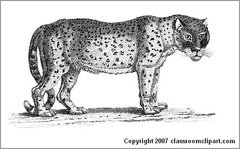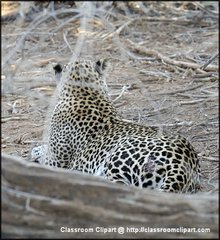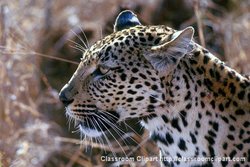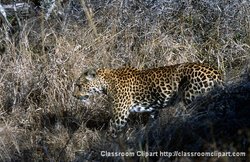Leopard
|
|
| Leopard Conservation status: Lower risk (lc) | ||||||||||||||
|---|---|---|---|---|---|---|---|---|---|---|---|---|---|---|
 African Leopard in Kenya | ||||||||||||||
| Scientific classification | ||||||||||||||
| ||||||||||||||
| Binomial name | ||||||||||||||
| Panthera pardus (Linnaeus, 1758) |
Leopards (Panthera pardus) are one of the four 'big cats' of the genus Panthera. (The others are the lion, tiger, and jaguar.) They range in size from 1 to almost 2 meters long, and weigh between 30 and 70 kg. Females are typically around two-thirds the size of males.
Most leopards are light tan or fawn with black spots, but their coats are very variable. The spots tend to be smaller on the head, larger and have pale centres on the body.
Originally, it was thought that a leopard was a hybrid between a lion and a panther, and the leopard's common name derives from this belief; leo is the Latin for lion, and pard is an old term meaning panther. A "panther" can be any of several species of large felid which happen to have genes for more black pigment than orange-tan pigment, thus producing a pure black coat as opposed to the usual spotted one. "Panthers", in other words, are dark-furred leopards (or a dark form of several other big cats: see black panther).
Prior to the human-induced changes of the last few hundred years, Leopards were the most widely distributed of all felids other than the domestic cat. Leopards can be found through most of Africa (with the exception of the Sahara Desert), as well as parts of Asia Minor and the Middle East, India, Pakistan, China, Siberia, much of mainland South-East Asia, and the islands of Java, Zanzibar, and Sri Lanka.
Leopards lifestyle and diet are as varied as that of any big cat. Leopards can hunt in trees as well as on the ground, and they feed on insects, rodents, fish, and larger game such as antelope. Leopards even prey upon dogs, themselves often formidable predators; those persons who keep dogs in leopard country are wise to keep dogs caged for their safety because leopards have been known to crave dog-meat. They are excellent tree climbers, and often protect their larger kills by carrying them up a tree.
Despite its size, this largely nocturnal and arboreal predator is difficult to see in the wild. Perhaps the best site is the Yala National Park in Sri Lanka, which has the world's highest density of wild leopards, but even here sightings are by no means guaranteed.
| Contents |
Attacks on humans
Leopards, despite their smaller size, are just as capable of killing humans as the larger cats. The Leopard of Rudraprayag is claimed to have killed over 125 people, and the Panar Leopard allegedly killed 400 after being injured by a poacher and thus unable to hunt normal prey. Both were eventually killed by famed big cat hunter and author Jim Corbett.
Hunting techniques
The leopard is a highly successful predator that hunts a wider variety of prey than most other big cats. In much of its range in Africa it competes with animals such as the Spotted Hyena and the lion for prey, and it is not uncommon for them to be chased away from their kills by other top predators. Leopards usually hunt at night, dawn, or dusk and will stalk their prey before they make the kill by biting the throat, essentially suffocating their prey. They will almost always drag their prey up to the relative safety of a tree. Leopards have been observed carrying prey three times their body weight into trees.
Distinguishing features
The big cats, especially the spotted cats, are easy to confuse for those who see them in captivity or in photographs. The leopard is closely related to, and appears very similar to, the jaguar; it is less often confused with the cheetah. The ranges, habitats, and activities of the three cats make them easy to distinguish in the wild.
Wild leopards and jaguars are difficult to mix up, as they inhabit different continents. There are also visual markings that set them apart. Leopards do not have the spots within the rosettes that jaguars always have, and the jaguar's spots are larger than the leopard's (see the photographs in jaguar). The Amur leopard and the North Chinese leopard are occasional exceptions. The leopard is smaller and less stocky than the jaguar, although it is more heavyset than the cheetah.
Besides appearance, the leopard and jaguar have different behavior patterns. Jaguars, adapted to life in the rainforest, are at home in the water, when the leopard usually avoids getting wet, and is more arboreal. Furthermore, the jaguar is native to the Americas, while the leopard is native to Asia and Africa.
The cheetah, although its range overlaps extensively with that of the leopard, is easily distinguished. The leopard is heavier, stockier, has a larger head in proportion to the body, and has rosettes rather than spots. The cheetah tends to run rather fast and goes much more quickly than the leopard. The cheetah also has dark 'teardrop'-like markings running down the sides of its face, whereas the leopard does not. Cheetahs are usually diurnal, while leopards are usually nocturnal; cheetahs are also exclusively terrestrial, while leopards often climb trees.
Conservation
The leopard is doing surprisingly well for a large predator. It is estimated that there are as many as 500,000 leopards in Sub-Saharan Africa alone. Because of their stealthy habits and camouflage, they can go undetected even in close proximity to human settlements. Despite the leopard's abilities, it is no match for habitat destruction and poachers, and several subspecies are endangered, namely, the Amur, Anatolian, Barbary, North Chinese, and South Arabian leopards.
Subspecies
There are between 7-30 subspecies of leopard (one of them extinct) though not all of these are accepted as distinct by all authorities; below is a list of some of the related animals and their Latin names.
- Clouded Leopard, Neofelis nebulosa
- Snow Leopard, Uncia uncia
- Lion, Panthera leo
- Tiger, Panthera tigris
- Jaguar, Panthera onca
- Subfamily Acinonychinae: Cheetah
Pictures and Clipart
- Leopard Pictures and Clipart (https://classroomclipart.com/clipart/Animals/Leopards.htm)
- Leopard Clipart (https://classroomclipart.com/clipart/Clipart/Animals/Leopard_Clipart.htm)
- Animal Clipart (https://classroomclipart.com/clipart/Clipart/Animals.htm)
- Pictures of Animals (https://classroomclipart.com/clipart/Animals.htm)





